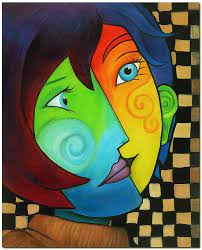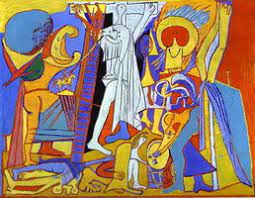All you need to know about Picasso's blue and rose periods
- Gurjas Chugh

- Apr 13, 2021
- 4 min read
Updated: Feb 3, 2022
Quite metaphorically, it is often said that art holds every emotion you feel and expresses it through the medium of millions of hues and a blank canvas. Well, that metaphor turns into a reality when it comes to the greatest artist of all time, Pablo Picasso.

Pablo Ruiz Picasso is the name that is so obvious to every art lover that it feels an insult to art itself if someone is unaware of his artistic significance. He created an entirely different era of his own in the world of art. Having lived in France, he did not only master portraits and paintings but also ceramics and sculptures.
He created thousands of paintings and changed the entire art culture by the phases he brought along. Be it from bringing about surrealism and portraits, to giving rise to the art of cubism, Pablo Picasso contributed more than anyone else and ruled over the hearts during the 20th century, and continues to live on in the hearts as the greatest artist of all times.
Out of all the phases he brought along, two of them that occurred simultaneously and also quite oppositely, were the blue and rose periods.
As interesting as they sound, these are all the facts you need to know about them and get an even deeper insight into the life of Picasso!
something more you'd like to read! 10 Amazing Facts about GUERNICA BY Pablo Picasso
THE BLUE PERIOD
What do we mean when we say that someone is in their blues? That's right, we mean to identify that the person is going through a tragic period, or is not well enough to feel happiness or peace of mind. Well, perhaps Pablo Picasso turned this proverb quite literally and brought it down in his art.
During the years from 1901 to 1904, the world saw Picasso's blue period. By this, it is meant that this was the time he expressed his turmoil and depression, the sadness of the world, and the depressing ongoings around him. His paintings, during this time, were quite literally, submerged in blues. The color blue dominated all of his artworks during this time, every painting mainly had shades of blue and green. Rarely any other color made its way to his canvas during this phase.
Losing a very close friend named Carlos Casagemas to suicide, Picasso suffered a great loss. In the turmoil, he created the famous La Vie in 1903. The artwork depicted his friend's inner sadness personified in a way that wanted to kill the person insanely and blindly in love with a failed relationship.

The time also influenced him in terms of poverty. Not only did he himself went through the sufferings during that time, but also saw the torturous ways in which others tried to make ends meet. Poverty, prostitution, labor, and every social issue during that phase saw their emergence in the form of his paintings, which were all about portraying those issues in the shades of blue.
This period of time in Picasso's paintings is called the blue period, which may have two senses. One, which depicts the depression under which Picasso's emotions turned into his expression of colors, and how he was in his blues. The other, which may depict how the color blue dominated his canvas for all those years that he went through.
something you'd like to read more about! Impact of art on your mental health
THE ROSE PERIOD
The blue period ended in 1904, and exactly when the rose period started. As the name suggests, by now you would have guessed which color this period saw.
The rose period in Picasso's artworks saw a change from a gloomy atmosphere into a more cheerful and happy one.
This was the time when Picasso settled and lived amongst Bohemian poets and writers, who understood their intellect, their perspective, and their understanding of the world. He got tremendously inspired and influenced by them and started with a new phase in his life. He saw the bright side and now created paintings with more earthly shades and tones, lighter colors, dominated by red and pink.
He began seeing the side of a cheerful approach, created paintings with the depiction of clowns, performers in carnivals, scenes, and situations of circus, and a lot of instances that influenced him along all those times. The rose period lasted from 1904 to 1906.
This phase mainly saw the rise in Picasso's new style and how he experimented with Primitivism. It was deeply related to African art as well, which later sees a whole new era ahead in his life.
So, this was about Picasso's Blue and Rose periods. When looked into deeply, they show how art has a lot of significance in what the person is going through, and how emotions always have a way of turning into expressions, be it in the form of music, dance, or art.

Tell us in the comment section if the information above helped you in any way, also do mention if we missed out on any fact.
Wishing you a creative escape ahead!

















Comments